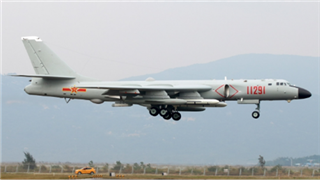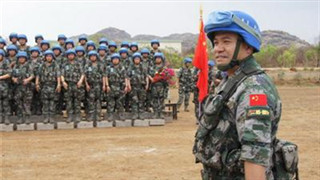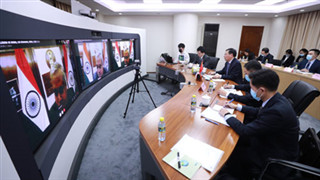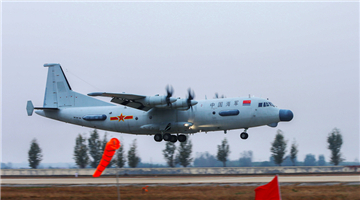(二)构建全民参与严密防控体系
2. A Tight Prevention and Control System Involving All Sectors of Society
针对春节期间人员密集、流动性大的特点,中国迅速开展社会动员、发动全民参与,坚持依法、科学、精准防控,在全国范围内实施史无前例的大规模公共卫生应对举措,通过超常规的社会隔离和灵活、人性化的社会管控措施,构建联防联控、群防群控防控体系,打响抗击疫情人民战争,通过非药物手段有效阻断了病毒传播链条。
The Chinese New Year is marked by enormous population flows in dense groups. In view of this fact, the Chinese government quickly mobilized the whole of society and galvanized the people into a nationwide response. A targeted, law- and science-based approach was adopted, and public health emergency response measures were rolled out on an unprecedented and extensive scale across the country. Through the strictest social distancing and flexible, people-centered social management, China put in place a prevention and control system involving governments at all levels and the whole of society, and launched a people's war on the virus applying non-medical means that has effectively blocked its transmission routes.
采取有力措施坚决控制传染源。以确诊患者、疑似患者、发热患者、确诊患者的密切接触者等“四类人员”为重点,实行“早发现、早报告、早隔离、早治疗”和“应收尽收、应治尽治、应检尽检、应隔尽隔”的防治方针,最大限度降低传染率。关闭离汉通道期间,武汉对全市421万户居民集中开展两轮拉网式排查,以“不落一户、不漏一人”标准实现“存量清零”,确保没有新的潜在感染源发生。持续提升核酸检测能力,增强试剂盒供应能力,扩充检测机构,缩短检测周期,确保检测质量,实现“应检尽检”“即收即检”。湖北省检测周期从2天缩短到4-6小时,日检测量由疫情初期的300人份提升到4月中旬的5万人份以上,缩短了患者确诊时间,降低了传播风险。在全国范围内排查“四类人员”,以社区网格为基础单元,采取上门排查与自查自报相结合的方式展开地毯式排查。全面实行各类场所体温筛查,强化医疗机构发热门诊病例监测和传染病网络直报,实行2小时网络直报、12小时反馈检测结果、24小时内完成现场流行病学调查,及时发现和报告确诊病例和无症状感染者。加强流行病学追踪调查,精准追踪和切断病毒传播途径,截至5月31日,全国累计追踪管理密切接触者74万余人。
Strong measures were taken to control sources of infection.The Chinese government defined a set of requirements: early detection, reporting, quarantine and treatment with a focus on the four categories of vulnerable people (confirmed cases, suspected cases, febrile patients who might be carriers, and close contacts). It had also taken measures to ensure that they were hospitalized, treated, tested or quarantined as appropriate. It has done everything in its power to reduce infections to the minimum.
While keeping all its outbound routes closed, Wuhan carried out two rounds of community-based mass screening of its 4.21 million households, leaving no person or household unchecked and ruling out all potential sources of infection.
The Chinese government redoubled efforts to increase the capacity of nucleic acid testing, supply more test kits, and approve more testing institutions. As a result, the testing period was shortened and the quality enhanced, ensuring that all those in need could be tested immediately and as appropriate. In Hubei Province, the testing period was shortened from 2 days to 4-6 hours, and the daily capacity expanded from 300 samples in the early stage of the epidemic to more than 50,000 in mid-April. Such advances made early detection and confirmation of infection possible and reduced the risk of transmission.
To identify the four categories of vulnerable people, community grid-based screening was carried out across the country. All residents were requested to report their health condition on a daily basis. Community workers for their part visited households door-to-door to collect and verify this information. Temperature checking was made a routine at all places. Work was done to strengthen the monitoring and online reporting of cases identified at fever clinics of medical facilities - all such cases had to be reported online to higher authorities within 2 hours; their test results sent back to the reporting clinics within 12 hours; and on-site epidemiological investigation completed within 24 hours - so that confirmed cases and asymptomatic carriers would be identified and reported without delay. Epidemiological tracing and investigation were enhanced to precisely detect and cut off virus transmission routes. As of May 31, a total of more than 740,000 close contacts had been traced and handled as appropriate.
第一时间切断病毒传播链。对湖北省、武汉市对外通道实施最严格的封闭和交通管控,暂停武汉及湖北国际客运航班、多地轮渡、长途客运、机场、火车站运营,全国暂停入汉道路水路客运班线发班,武汉市及湖北省多地暂停市内公共交通,阻断疫情向全国以及湖北省内卫生基础设施薄弱的农村地区扩散。对湖北以外地区实施差异化交通管控,湖北省周边省份筑牢环鄂交通管控“隔离带”,防止湖北省疫情外溢蔓延。全国其他地区实行分区分级精准防控,对城乡道路运输服务进行动态管控,加强国内交通卫生检疫。采取有效措施避免人员聚集和交叉感染,延长春节假期,取消或延缓各种人员聚集性活动,各类学校有序推迟开学;关闭影院、剧院、网吧以及健身房等场所;对车站、机场、码头、农贸市场、商场、超市、餐馆、酒店、宾馆等需要开放的公共服务类场所,以及汽车、火车、飞机等密闭交通工具,落实环境卫生整治、消毒、通风、“进出检”、限流等措施,进入人员必须测量体温、佩戴口罩;推行政务服务网上办、预约办,推广无接触快递等“不见面”服务,鼓励民众居家和企业远程办公,有效减少人员流动和聚集;在公共场所设置“一米线”并配以明显标识,避免近距离接触。全国口岸实施严格的出入境卫生检疫,防范疫情通过口岸扩散蔓延。实施最严边境管控,取消非紧急非必要出国出境活动。
Breaking the chains of transmission through early intervention. The strictest closure and traffic restrictions were enforced on all outbound routes from Wuhan and Hubei. International passenger flights, and ferries and long-distance passenger transport services in many parts of the province were suspended, as were road and waterway passenger services bound for Wuhan from other places of the country. Airports and railway stations were closed and intra-city public transport halted in Wuhan and many other parts of Hubei. All these restrictions effectively stopped the virus from spreading nationwide, especially in rural Hubei where public health infrastructure was relatively weak.
Areas outside Hubei took a differentiated approach to traffic control. The provinces abutting Hubei built traffic control "isolation zones" around the province, preventing the virus from spreading beyond Hubei. Other parts of China adopted a targeted, tiered, and region-specific approach. They exercised a dynamic control over urban and rural road transport services and strengthened health and quarantine measures for domestic routes.
Rigorous measures were taken to prevent public gatherings and cross-infection. The Chinese New Year holiday was extended, public gatherings were canceled or postponed, and the spring semester was postponed in schools. Cinemas, theaters, internet cafés, and gyms were all closed. Strict procedures had to be followed in essential public facilities, including bus stations, airports, ports, farmers markets, shopping malls, supermarkets, restaurants and hotels, and in enclosed transport vehicles such as buses, trains and planes. All persons were required to wear masks and undergo temperature monitoring when accessing these venues or vehicles. In addition, all such facilities had to be disinfected, meet certain hygiene standards, ensure good ventilation, monitor visitors' temperature, and control the number of passengers or visitors at a given period of time.
Government services were provided online and through prior reservation, non-physical-contact delivery or services were extended, people were encouraged to stay at home and work from home, and businesses were encouraged to telecommute - all these measures effectively reduced population flows and public gatherings. Clear signs urging people to maintain at least one meter of distance and avoid close contact could be seen in all public places.
Strict health and quarantine measures were enforced at points of entry and exit across China to prevent inbound and outbound spread of the virus. The strictest-ever measures were applied at border control to suspend non-urgent and nonessential outbound travel by Chinese citizens.
牢牢守住社区基础防线。城乡社区是疫情联防联控的第一线,是外防输入、内防扩散的关键防线。充分发挥基层主体作用,加强群众自治,实施社区封闭式、网格化管理,把防控力量、资源、措施向社区下沉,组建专兼结合工作队伍,充分发挥街道(乡镇)和社区(村)干部、基层医疗卫生机构医务人员、家庭医生团队作用,将一个个社区、村庄打造成为严密安全的“抗疫堡垒”,把防控有效落实到终端和末梢。按照“追踪到人、登记在册、社区管理、上门观察、规范运转、异常就医”的原则,依法对重点人群进行有效管理,开展主动追踪、人员管理、环境整治和健康教育。武汉市全面实施社区24小时封闭管理,除就医和防疫相关活动外一律禁止出入,由社区承担居民生活保障。其他地方对城市社区、农村村落普遍实施封闭式管理,人员出入检查登记、测量体温。加强居民个人防护,广泛开展社会宣传,强化个体责任意识,自觉落实居家隔离以及跨地区旅行后隔离14天等防控要求,严格执行外出佩戴口罩、保持社交距离、减少聚集等防护措施,养成勤洗手、常通风等良好生活习惯。大力开展爱国卫生运动,提倡文明健康、绿色环保的生活方式。
The community-based line of defense was well guarded. Communities and villages made up the first line of defense in epidemic prevention and control, a major barrier to inbound cases and local transmission. They served as the mainstay in China's Covid-19 response. Residents and villagers were mobilized to help manage communities. Strict access control and grid-based management were exercised in communities, and human and material resources were channeled down to the community level to reinforce implementation of targeted measures. Task forces comprising both full-time and part-time community workers were set up, while officials at the sub-district/township and community/village levels, health workers of community medical facilities, and family doctors all performed their duties as a team. Through all these efforts, communities and villages were turned into strongholds, securing full implementation of response measures down to the lowest level.
To deal with the four categories of vulnerable people, a number of measures were taken in accordance with the law, such as tracing, registering, and visiting each individual, placing them under community management, and transferring them, if necessary, to designated medical facilities for quarantine or treatment as per due procedures. Community actions were taken to keep local areas in good condition and promote health education.
In Wuhan, rigorous 24-hour access control was enforced in all residential communities. No residents were allowed to leave and no non-residents allowed to access the community area other than for essential medical needs or epidemic control operations. Community workers were responsible for the purchase and delivery of daily necessities according to residents' needs. This approach was also applied in communities and villages in other parts of China, where all residents had to register and undergo temperature checking when leaving or entering the residential area or village.
Education programs were conducted to raise public awareness of the need for personal protection and enhance the sense of social responsibility. People observed self-quarantine at home and 14-day self-isolation after cross-region travel. They strictly followed personal protection measures such as wearing a mask when going out, maintaining proper social distancing, avoiding crowds, frequent handwashing, and regular ventilation. The tradition of the Patriotic Public Health Campaign which was initiated in the 1950s, with an emphasis on sanitation and personal hygiene, was also encouraged, along with a healthy, environment-friendly lifestyle .
实施分级、分类、动态精准防控。全国推行分区分级精准施策防控策略,以县域为单位,依据人口、发病情况综合研判,划分低、中、高疫情风险等级,分区分级实施差异化防控,并根据疫情形势及时动态调整名单,采取对应防控措施。低风险区严防输入,全面恢复生产生活秩序;中风险区外防输入、内防扩散,尽快全面恢复生产生活秩序;高风险区内防扩散、外防输出、严格管控,集中精力抓疫情防控。本土疫情形势稳定后,以省域为单元在疫情防控常态化条件下加快恢复生产生活秩序,健全及时发现、快速处置、精准管控、有效救治的常态化防控机制。全力做好北京市疫情防控,确保首都安全。做好重点场所、重点单位、重点人群聚集性疫情防控和处置,加强老年人、儿童、孕产妇、学生、医务人员等重点人群健康管理,加强医疗机构、社区、办公场所、商场超市、客运场站、交通运输工具,托幼机构、中小学校、大专院校以及养老机构、福利院、精神卫生医疗机构、救助站等特殊场所的管控,覆盖全人群、全场所、全社区,不留死角、不留空白、不留隐患。针对输入性疫情,严格落实国境卫生检疫措施,强化从“国门”到“家门”的全链条、闭环式管理,持续抓紧抓实抓细外防输入、内防反弹工作。
A multi-level, category-specific, dynamic and targeted approach was adopted. China also applied a region-specific, multi-level approach to epidemic prevention and control. To better prevent and control the epidemic, each region at or above the county level was classified by risk level on the basis of a comprehensive evaluation of factors such as population and number of infections in a given period of time. There are three levels of risk: low, medium, and high. Regions could take measures according to the risk level, which was dynamic and adjusted in light of the evolving situation.
In response to Covid-19, a low-risk region was requested to remain vigilant against any potential inbound transmission while fully restoring normal order in work and daily life; a medium-risk region had to prevent inbound and local transmission while restoring normal work and daily life as soon as possible; and a region classified as high-risk was obliged to prevent any spread in its jurisdiction or beyond, enforce strict control measures, and focus on containment. Once the situation stabilized, provincial-level authorities could step up efforts to restore order in work and daily life in areas under their jurisdiction, while adapting to the new normal of Covid-19 control by establishing a sound long-term epidemic response system that ensures early detection, quick response, targeted prevention and control, and effective treatment. Every effort has been made to stem the virus spread in the capital of Beijing to safeguard public health.
Appropriate measures were implemented to prevent any cluster outbreaks in key locations, major organizations, and priority population groups, and manage the aftermath of any such outbreaks. The elderly, children, pregnant women, students, and health workers were to be well protected as a priority.
Health management of priority population groups was enhanced. Protective measures were intensified in medical facilities, communities, office buildings, shopping malls and supermarkets, passenger terminals, transport vehicles, child-care centers and kindergartens, elementary and secondary schools, colleges and universities, nursing homes, charity houses, mental health institutions, and first-aid stations. These measures were implemented nationwide, covering all population groups, locations, and communities, and leaving no areas unattended and no hidden dangers unaddressed.
To control any inbound infections from overseas, China has strictly enforced its border health and quarantine rules to ensure a full, closed cycle of management of all arrivals, from their entry at the border to the doorstep of where they would stay. Sustained, meticulous efforts have been made to prevent both inbound cases and a recurrence in domestic cases.
为疫情防控提供有力法治保障。依法将新冠肺炎纳入《中华人民共和国传染病防治法》规定的乙类传染病并采取甲类传染病的预防、控制措施,纳入《中华人民共和国国境卫生检疫法》规定的检疫传染病管理,同时做好国际国内法律衔接。一些地方人大常委会紧急立法,在国家法律和法规框架下授权地方政府在医疗卫生、防疫管理等方面,规定临时性应急行政管理措施。严格执行传染病防治法及其实施办法等法律法规,出台依法防控疫情、依法惩治违法犯罪、保障人民生命健康安全的意见,加强治安管理、市场监管,依法惩处哄抬物价、囤积居奇、制假售假等破坏疫情防控的违法犯罪行为,强化防疫物资质量和价格监管,加大打击虚假违法广告力度,保障社会稳定有序。加强疫情防控期间行政执法监督,严格规范执法,公正文明执法,依法化解与疫情相关的法律纠纷,为疫情防控和企业复工复产提供法律保障和服务。加强普法宣传,引导公众依法行事。
Legal safeguards for epidemic prevention and control were strengthened. China listed Covid-19 as a Class B infectious disease, but addressed it with measures applicable to a Class A infectious disease under the Law of the People's Republic of China on Prevention and Treatment of Infectious Diseases. It also applied control and quarantine measures under the Frontier Health and Quarantine Law of the People's Republic of China consistent with relevant provisions of international law and other domestic laws. Standing committees of some sub-national people's congresses launched emergency legislation procedures as per the national legal framework, empowering local governments to introduce interim emergency administrative rules relating to healthcare and epidemic control.
The Law on Prevention and Treatment of Infectious Diseases and measures for its implementation have been strictly enforced, and guidelines have been promulgated on controlling the disease, combating epidemic-related crimes in accordance with the law, and protecting people's lives and health. Law and order, and market supervision have been strengthened. Price gouging, hoarding and profiteering, production and sales of counterfeit or sub-standard products, and any other crimes impeding response efforts have been punished by law. Quality and price control of anti-epidemic supplies has been reinforced, and stronger measures have been taken against deceptive and illegal advertising, ensuring social order and stability. Supervision on administrative law enforcement has been intensified during epidemic control to ensure that the law is enforced in a strict, impartial, procedure-based, and non-abusive way. Legal disputes associated with the epidemic have been resolved in accordance with the law, and legal guarantees and services have been provided for Covid-19 response and for businesses returning to work. The government has also made greater efforts to raise public legal awareness and guide people to act within the parameters of the law.
遵循科学规律开展防控。新冠病毒是新病毒,对其认识需要有个过程。积极借鉴以往经验,紧密结合中国国情,遵循流行病学规律,探索行之有效的方法手段,用中国办法破解疫情防控难题。注重发挥病毒学、流行病学、临床医学等领域专家作用,及时开展疫情形势分析研判,提出防控策略建议,充分尊重专家意见,增强疫情防控的科学性专业性。秉持科学态度,加强病毒感染、致病机理、传播途径、传播能力等研究,与世界卫生组织及其他国家和地区保持沟通交流。随着对病毒认识的不断深化,及时调整和优化工作措施,不断提升防控水平。根据疫情形势变化和评估结果,先后制修订6版新冠肺炎防控方案,科学规范开展病例监测、流行病学调查、可疑暴露者和密切接触者管理以及实验室检测等工作。针对重点人群、重点场所、重点单位发布15项防控技术方案、6项心理疏导工作方案,并细化形成50项防控技术指南,进一步提高疫情防控的科学性精准性。
Prevention and control efforts have been based on science. Covid-19 is a new virus and it will take time for humanity to understand it completely. In its quest for victory over the coronavirus, China has been mapping its own route to success - one based on reliable experience, tailored to its national conditions, and rooted in sound epidemiological practice.
China values the role of experts in virology, epidemiology, clinical medicine and related fields. China's response has been professional because its response measures were based on timely analyses and assessments by scientists and public health experts, whose views and proposals were fully respected.
China has given full support to factual and scientific research on virus infection, pathogenesis, transmission routes and transmissibility while maintaining exchanges and communication with the WHO and other countries and regions.
With a growing body of knowledge of the virus, China has modified and optimized its response measures in a timely manner to make them more effective. It has developed a Covid-19 prevention and control protocol and updated it five times based on assessments of the evolving epidemic dynamics. The protocol provides a set of reliable standards for case monitoring, epidemiological investigation, management of close contacts and of those suspected of exposure to infection, and procedure-based tests in laboratories. China has also published 15 technical manuals on epidemic prevention and control for key population groups, locations and organizations, 6 work plans on psychological counseling for people affected by Covid-19, and 50 specific technical guidelines. All of this has ensured that China's prevention and control efforts are more targeted and science-based.
(二)全力救治患者、拯救生命
3. An All-Out Effort to Treat Patients and Save Lives
医疗救治始终以提高收治率和治愈率、降低感染率和病亡率的“两提高”“两降低”为目标,坚持集中患者、集中专家、集中资源、集中救治“四集中”原则,坚持中西医结合,实施分类救治、分级管理。对重症患者,调集最优秀的医生、最先进的设备、最急需的资源,不惜一切代价进行救治,大幅度降低病亡率;对轻症患者及早干预,尽可能在初期得以治愈,大幅度降低转重率。
From the outset, China's goal in its medical response to Covid-19 has been to improve the patient admission and cure rates and reduce the infection and fatality rates. The infected were treated in dedicated medical facilities where medical specialists from all over the country and all the necessary medical resources were concentrated. Both traditional Chinese medicine and Western medicine were applied. A condition-specific and category-based approach was applied to medical treatment of patients. Severe cases were treated by the best doctors using the most advanced equipment, and critical supplies were pooled to save lives at all costs. It is through such efforts that the Covid-19 fatality rate in China has dropped sharply. Early medical intervention has made it possible to have patients with mild symptoms cured without delay, thus significantly reducing the risk that their condition might worsen.
集中优势资源加强重症救治。疫情突发导致武汉市医疗资源挤兑。针对疫情初期患者数量激增与床位资源不足的突出矛盾,集中资源和力量在武汉市建设扩充重症定点医院和救治床位,将全部重症危重症患者集中到综合实力最强且具备呼吸道传染性疾病收治条件的综合医院集中开展救治。建成火神山、雷神山两座各可容纳1000多张床位的传染病专科医院,改扩建一批定点医院,改造一批综合医院,使重症床位从1000张左右迅速增加至9100多张,解决了重症患者大规模收治难题。优化重症救治策略,制定个体化医疗救治方案。建立专家巡查制度,定期组织专家团队对武汉市定点医院重症患者救治进行巡诊,评估患者病情和治疗方案。针对超过80%的重症患者合并严重基础性疾病情况,实行“一人一策”,建立感染、呼吸、重症、心脏、肾脏等多学科会诊制度,并制定重症、危重症护理规范,推出高流量吸氧、无创和有创机械通气、俯卧位通气等措施。严格落实疑难危重症患者会诊制度、死亡病例讨论制度等医疗质量安全核心制度,强化对治愈出院患者健康监测,确保重症患者救治质量。开展康复者恢复期血浆采集和临床治疗工作,建立应急储备库,截至5月31日,全国共采集恢复期血浆2765人次,1689人次患者接受恢复期血浆治疗,取得较好治疗效果。
Pooling premium resources to treat severe cases. The sudden appearance of Covid-19 in Wuhan put an overwhelming strain on its medical resources. There was a severe shortage of hospital beds in the early stage as the number of infections surged. By directing resources to Wuhan, China expanded the capacity of designated hospitals to deal with severe cases and increased the number of beds. Patients in severe and critical condition were gathered for treatment and intensive care at the best hospitals with the greatest capacity for accommodating patients with infectious respiratory diseases. Two hospitals with 1,000-plus beds each - Huoshenshan and Leishenshan - were built as specialist hospitals for treating infectious diseases, and a number of designated and general hospitals were expanded or remodeled. The number of beds for severe cases quickly increased from around 1,000 to more than 9,100. Hospitals were able to admit large numbers of patients who were seriously ill.
The treatment strategy for severe cases was improved, and tailored treatment provided to individual patients. Inspection teams consisting of top experts were organized to regularly inspect Wuhan's designated hospitals and evaluate patients in critical condition and their therapeutic regimen. For those with serious underlying medical conditions, who accounted for more than 80 percent of all severe cases, case-by-case treatment was prescribed after consultation with a multidisciplinary team consisting of experts on infection, respiratory diseases, heart and kidney diseases, and intensive care. In addition, a set of standards were formulated for nursing patients in severe and critical condition, and such measures as high-flow nasal cannula oxygen therapy, non-invasive and invasive mechanical ventilation, and ventilation in a prone position were adopted. Expert consultation on complex, severe and critical cases, and fatal cases, and other core medical security systems were strictly implemented. Those who have been cured and discharged from hospital have received rigorous health monitoring, and patients in severe condition have been given quality medical treatment.
The plasma of convalescent Covid-19 patients has been collected to set up an emergency plasma reserve, and convalescent plasma therapy has been applied in clinical treatment. As of May 31, convalescent plasma had been collected from 2,765 recovered patients, and 1,689 patients had been treated with the therapy, with positive results.
对轻症患者及早干预治疗。及时收治轻症患者,及早实施医疗干预,尽量减少轻症转为重症。完善临床救治体系,全国共指定1万余家定点医院,对新冠肺炎患者实行定点集中治疗。建立全国医疗救治协作网络,通过远程会诊方式提供技术支持。武汉市针对患者数量急剧增长、80%左右是轻症的情况,集中力量将一批体育场馆、会展中心等改造成16家方舱医院,床位达到1.4万余张,使轻症患者应收尽收、应治尽治,减少了社区感染传播,减少了轻症向重症转化。16家方舱医院累计收治患者1.2万余人,累计治愈出院8000余人、转院3500余人,实现“零感染、零死亡、零回头”。方舱医院是阻击重大传染病的重大创新,使“应收尽收”“床位等人”成为现实,有力扭转了防控形势。英国《柳叶刀》社论认为,“中国建造的方舱庇护医院对于缓解医疗卫生系统所承受的巨大压力有着至关重要的作用”。
Early intervention for patients with mild symptoms. China has been quick to have patients with mild symptoms admitted to designated medical facilities for early medical intervention, and has done its best to prevent mild cases from worsening. The national clinical treatment network has been expanded to include more than 10,000 hospitals dedicated to the treatment of Covid-19 patients. A national network of medical treatment coordination has also been formed to provide technical support through online consultation.
In Wuhan, faced with surging infections and considering that 80 percent of cases were mild, the city government mobilized resources to repurpose stadiums and exhibition centers into 16 temporary treatment centers. With some 14,000 beds, these centers were able to admit all confirmed mild cases for treatment. This helped to reduce infections and virus transmission in communities and prevent mild cases from worsening. The 16 treatment centers received a total of more than 12,000 patients; 8,000 and more were cured and discharged; and more than 3,500 were transferred to hospitals. While in service, these facilities had zero cases of infection, death, or relapse.
Temporary treatment centers, or Fangcang shelter hospitals, are a major innovative solution that provided enough beds to admit all confirmed cases, thus turning the tide in the battle against Covid-19. An article in The Lancet wrote, "To relieve the huge pressure on the healthcare system, Fangcang shelter hospitals have also been crucial."
及时总结推广行之有效的诊疗方案。坚持边实践、边研究、边探索、边总结、边完善,在基于科学认知和证据积累的基础上,将行之有效的诊疗技术和科技研究成果纳入诊疗方案。先后制修订7版新冠肺炎诊疗方案,3版重型、危重型病例诊疗方案,2版轻型、普通型管理规范,2版康复者恢复期血浆治疗方案,1版新冠肺炎出院患者主要功能障碍康复治疗方案,提高了医疗救治工作的科学性和规范性。最新的第7版新冠肺炎诊疗方案增加病理改变内容,增补和调整临床表现、诊断标准、治疗方法和出院标准等,并纳入无症状感染者可能具有感染性、康复者恢复期血浆治疗等新发现。目前,第7版诊疗方案已被多个国家借鉴和采用。强化治愈出院患者隔离管理和健康监测,加强复诊复检和康复,实现治疗、康复和健康监测一体化全方位医疗服务。注重孕产妇、儿童等患者差异性诊疗策略,实现不同人群诊疗方案的全覆盖。
Reviewing diagnostic and therapeutic plans and applying effective ones on a broad scale. China's diagnostic and therapeutic plans for Covid-19 have been developed and improved through clinical practice, medical research, experimentation and regular reviews. Based on scientific knowledge and accumulated evidence, R&D results and the diagnostic and therapeutic regimens that proved effective were incorporated in the national diagnosis and treatment plans. These include seven versions of the diagnosis and treatment protocol, three editions of the protocol for severe and critical cases, two editions of the manual for mild case management, two editions of convalescent plasma therapy treatment protocol, and one rehabilitation treatment program for patients discharged from hospitals. All these protocols and plans have contributed to science-based treatment of patients and the establishment of standards for medical treatment.
In Diagnosis and Treatment Protocol for Covid-19 (Trial Version 7), information on pathological changes, clinical symptoms, criteria for diagnosis, therapies, and criteria for patient discharge was added or updated. The protocol states that asymptomatic cases may be contagious. It also notes that plasma from convalescent cases may work in treating the infected. This edition has been adopted or used for reference in a number of countries.
Concerning discharged patients, quarantining, monitoring of their health and rehabilitation, and reexamination and re-testing have all been strengthened. Integrated medical services covering treatment, rehabilitation and health monitoring have been put in place. Differentiated treatment approaches have been adopted for children and pregnant women, among other groups.
充分发挥中医药特色优势。坚持中西医结合、中西药并用,发挥中医药治未病、辨证施治、多靶点干预的独特优势,全程参与深度介入疫情防控,从中医角度研究确定病因病基、治则治法,形成了覆盖医学观察期、轻型、普通型、重型、危重型、恢复期发病全过程的中医诊疗规范和技术方案,在全国范围内全面推广使用。中医医院、中医团队参与救治,中医医疗队整建制接管定点医院若干重症病区和方舱医院,其他方舱医院派驻中医专家。中医药早期介入、全程参与、分类救治,对轻症患者实施中医药早介入早使用;对重症和危重症患者实行中西医结合;对医学观察发热病人和密切接触者服用中药提高免疫力;对出院患者实施中医康复方案,建立全国新冠肺炎康复协作网络,提供康复指导。中医药参与救治确诊病例的占比达到92%。湖北省确诊病例中医药使用率和总有效率超过90%。筛选金花清感颗粒、连花清瘟胶囊/颗粒、血必净注射液和清肺排毒汤、化湿败毒方、宣肺败毒方等“三药三方”为代表的针对不同类型新冠肺炎的治疗中成药和方药,临床疗效确切,有效降低了发病率、转重率、病亡率,促进了核酸转阴,提高了治愈率,加快了恢复期康复。
Leveraging the unique strength of traditional Chinese medicine (TCM). Both TCM and Western medicine were used and traditional Chinese and Western drugs administered. China has leveraged the unique strength of TCM in preemptive prevention, differentiated medication, and multi-targeted intervention, and at every step of Covid-19 treatment and control. The etiology and pathogen of the disease were analyzed and confirmed through TCM methodology, as were the principles and methods of treatment. A set of TCM diagnosis and treatment protocols were developed to cover the entire process of medical observation, treatment of mild, moderate, severe, and critical cases, and recovery, and they have been applied nationwide.
TCM hospitals were used in the treatment of Covid-19 patients, and TCM teams took charge of and ran some wards for patients in severe condition at designated hospitals and some treatment centers. All the other shelter hospitals had resident TCM experts. TCM has played its part in the entire process of Covid-19 response, from early intervention to administering case-specific treatment. TCM drugs and treatment methods were used for early intervention and treatment of patients with mild symptoms; for patients with severe symptoms they were used in combination with Western medicine; for those under medical observation for fever and those who had been in close contact with confirmed cases they served to improve immunity; they helped to strengthen the constitution of those who had recovered. A national TCM coordination network was formed to offer guidance to patients recovering from the disease.
Chinese herbal formulas and drugs were administered to 92 percent of all confirmed cases. In Hubei Province, more than 90 percent of confirmed cases received TCM treatment that proved effective. Jinhua Qinggan Granules, Lianhua Qingwen Capsules/Granules, Xuebijing Injection, Lung Cleansing and Detoxifying Preparation, Dampness Resolving and Detoxifying Preparation, Lung Diffusing and Detoxifying Preparation, and other TCM drugs and herbal formulas have proved effective in treating different types of Covid-19 patients. They have significantly reduced the incidence rate, prevented cases with mild symptoms from worsening, increased the cure rate, lowered the fatality rate, helped nucleic acid turn negative, and sped up the rehabilitation of recovered Covid-19 patients.
实施患者免费救治。及时预拨疫情防控资金,确保患者不因费用问题影响就医,确保各地不因资金问题影响医疗救治和疫情防控。截至5月31日,全国各级财政共安排疫情防控资金1624亿元。及时调整医保政策,明确确诊和疑似患者医疗保障政策,对确诊和疑似患者实行“先救治,后结算”。对新冠肺炎患者(包括确诊和疑似患者)发生的医疗费用,在基本医保、大病保险、医疗救助等按规定支付后,个人负担部分由财政给予补助。异地就医医保支付的费用由就医地医保部门先行垫付。截至5月31日,全国确诊住院患者结算人数5.8万人次,总医疗费用13.5亿元,确诊患者人均医疗费用约2.3万元。其中,重症患者人均治疗费用超过15万元,一些危重症患者治疗费用几十万元甚至上百万元,全部由国家承担。
Providing free treatment for patients. Government funds for Covid-19 control were made available in advance to ensure that patients could receive timely treatment and local authorities could proceed smoothly with measures for medical treatment and epidemic control. As of May 31, a total of RMB162.4 billion had been allocated by governments of all levels to fight the virus.
Policies for medical insurance were quickly adjusted, with clear provisions for confirmed or suspected Covid-19 patients. They could get treatment with delayed settlement of accounts. All Covid-19 patients, confirmed or suspected, received subsidies from state finance for any medical bills not covered by basic medical insurance, serious disease insurance, or the medical assistance fund. In the case of patients receiving treatment in places where they were not registered for basic medical insurance, their medical bills related to Covid-19 were paid by the local insurance fund first and settled later.
As of May 31, the medical bills of 58,000 inpatients with confirmed infections had been settled by basic medical insurance, with a total expenditure of RMB1.35 billion, or RMB23,000 per person. The average cost for treating Covid-19 patients in severe condition surpassed RMB150,000, and in some critical cases the individual cost exceeded RMB1 million, all covered by the state.
加强医疗机构感染控制和医务人员防护。制定感染控制技术指南和制度文件,明确医疗机构重点区域、就诊流程“三区两通道”建筑布局要求。加强对医务人员的感染控制培训,开展全国督导,确保感染控制措施落实。对疫情严重、院内感染风险高、医疗救治压力大的重点地区重点医院,有针对性地开展指导。加强医疗废物分类收集、运送贮存,做好病亡者遗体处置。在援鄂援汉医疗队中配置感染控制专家,全国支援湖北省和武汉市的医务人员没有感染病例。2月份以后,全国医务人员感染病例报告数明显减少。关心关爱医务人员,制定一系列保障政策,开展心理疏导,妥善安排轮换休整,缓解身体和心理压力,保持一线医务人员战斗力。
Strengthening infection control at medical institutions and ensuring personal protection for health workers. A set of technical manuals and normative documents on infection control were developed to regulate the layout of key areas in medical institutions and the consultation and treatment process, including clean zones, partially contaminated zones, contaminated zones, and separate passages for medical staff and patients. Health workers received training in workplace infection control, and nationwide supervision was strengthened to ensure control measures were implemented to the letter. Targeted guidance was given to the hardest-hit areas, hospitals at a higher risk of infection among staff, and areas and hospitals under the greatest pressure in treating patients. A major effort was put into the sorting, collection, storage and removal of medical waste, and the treatment of the remains of the deceased.
All emergency medical teams coming to Wuhan and Hubei from other parts of China had at least one infection control expert. Thanks to this arrangement, there have been no cases of infection in the teams. Since February there has been a sharp drop in the number of reported infections among medical staff nationwide. Health workers have been cared for and their needs attended to. A series of policies and measures have been introduced to ensure their wellbeing, such as psychological counseling and staff rotation, to ease their physical and psychological stress, help them stay healthy, and allow them to continue the fight on the front line.
(四)依法及时公开透明发布疫情信息
4. China Has Released Information in an Open and Transparent Manner as Required by Law
在全力做好疫情防控的同时,中国以对生命负责、对人民负责、对历史负责、对国际社会负责的态度,建立最严格且专业高效的信息发布制度,第一时间发布权威信息,速度、密度、力度前所未有。持续、权威、清晰的疫情信息,有效回应了公众关切、凝聚了社会共识,为其他国家提供了参考和借鉴。
While making an all-out effort to contain the virus, China has also acted with a keen sense of responsibility to humanity, its people, posterity, and the international community. It has provided information on Covid-19 in a thoroughly professional and efficient way. It has released authoritative and detailed information as early as possible on a regular basis, thus effectively responding to public concern and building public consensus. Its experience is something other countries can draw on in their fight against the virus.
建立严格的疫情发布机制。依法、及时、公开、透明发布疫情信息,制定严格规定,坚决防止瞒报、迟报、漏报。武汉市从2019年12月31日起依法发布疫情信息,并逐步增加信息发布频次。2020年1月21日起,国家卫生健康委每日在官方网站、政务新媒体平台发布前一天全国疫情信息,各省级卫生健康部门每日统一发布前一天本省份疫情信息。2月3日起,国家卫生健康委英文网站同步发布相关数据。
A strict system of information release has been established. China has released information on Covid-19 in a timely, open and transparent manner as required by law. Strict regulations are in place to see there is no withholding of information, underreporting, or delay in reporting cases of infection. On December 31, 2019, the Wuhan government began to release coronavirus information in accordance with the law, and gradually increased the frequency of release. Since January 21, 2020, the NHC has provided daily updates on nationwide cases on its official website and social media platform, and provincial health departments have done the same on local cases. Starting from February 3, the NHC has released the information simultaneously on its English-language website.
建立分级分层新闻发布制度。坚持国家和地方相结合、现场发布与网上发布相结合,建立多层次多渠道多平台信息发布机制,持续发布权威信息,及时回应国内外关注的疫情形势、疫情防控、医疗救治、科研攻关等热点问题。截至5月31日,国务院联防联控机制、国务院新闻办公室共举行新闻发布会161场,邀请50多个部门490余人次出席发布会,回答中外媒体1400多个提问;湖北省举行103场新闻发布会,其他省份共举行1050场新闻发布会。
A tiered news release mechanism has been formed.At both national and local levels, a tiered information release mechanism has been formed to circulate authoritative information through various channels and platforms, both onsite and online, in order to address domestic and international concerns on virus control, medical treatment, and scientific research. By May 31, the Joint Prevention and Control Mechanism and the Information Office of the State Council had held 161 press conferences during which officials from more than 50 government departments appeared over 490 times and answered more than 1,400 questions from Chinese and foreign media. One hundred and three press conferences had been held in Hubei and 1,050 in the other provinces.
依法适时订正病例数据。本土疫情得到控制后,为确保公开透明、数据准确,武汉市针对疫情早期因收治能力不足导致患者在家中病亡、医院超负荷运转、死亡病例信息登记不全等原因,客观上存在迟报、漏报、误报现象,根据相关法律规定,在深入开展涉疫大数据与流行病学调查的基础上,对确诊和死亡病例数进行了订正,并向社会公开发布。
Covid-19 statistics have been updated in accordance with the law. In the early stage of Covid-19 control, there were late, incomplete and erroneous reports of Covid-19 cases in Wuhan due to unverified deaths at home, inadequate hospital capacity, hospitals being overwhelmed, and incomplete recording of deaths. After the domestic spread of Covid-19 had been brought under control, the city updated the number of confirmed cases and deaths based on big data application and an epidemiological investigation to ensure accuracy of the data, and released the results in an open and transparent manner in accordance with the law.
多渠道多平台传播信息。国家卫生健康委中、英文官方网站和政务新媒体平台设置疫情防控专题页面,发布每日疫情信息,解读政策措施,介绍中国抗疫进展,普及科学防控知识,澄清谣言传言。各省(自治区、直辖市)政府网站及政务新媒体平台及时发布本地疫情信息和防控举措。大力开展应急科普,通过科普专业平台、媒体和互联网面向公众普及科学认知、科学防治知识,组织权威专家介绍日常防控常识,引导公众理性认识新冠肺炎疫情,做好个人防护,消除恐慌恐惧。加强社会舆论引导,各类媒体充分传递抗击疫情正能量,同时发挥舆论监督作用,推动解决疫情防控中出现的问题。
Covid-19-related information is provided through various channels and platforms. The NHC's official Chinese and English websites and its social media platform have special sections where Covid-19-related information is released on a daily basis, including information on relevant policies, progress in China's containment efforts, updates on disease prevention and control, and clarifications that refute rumors. Information on local Covid-19 control has been promptly released on government websites and social media platforms of all provinces. To disseminate knowledge about its Covid-19 response, China has released relevant information through platforms for popularizing science, and through the media and the internet. Leading medical experts have offered advice on routine self-protection to help the public see Covid-19 in a rational way and forestall panic. The media has expanded public outreach and sent a positive message in combating the virus, and public opinion has played its role of oversight to help solve problems affecting virus control.
(五)充分发挥科技支撑作用
5. Science and Technology Underpin China's Efforts
科学技术是人类同疾病较量的锐利武器,人类战胜大灾大疫离不开科学发展和技术创新。面对人类未知的新冠病毒,中国坚持以科学为先导,充分运用近年来科技创新成果,组织协调全国优势科研力量,以武汉市为主战场,统筹全国和疫情重灾区,根据疫情发展不同阶段确定科研攻关重点,坚持科研、临床、防控一线相互协同和产学研各方紧密配合,为疫情防控提供了有力科技支撑。
Science and technology are the sharp blade that humanity wields in the battle against disease. Such battles could not have been won without scientific advances and technological innovation. Confronted by Covid-19, a previously unknown virus, China has exploited the pioneering role of science and technology and fully applied the results of scientific and technical innovation in recent years. Top scientific research resources have gathered from around the nation to support virus control. Focusing on the main battlefield of Wuhan and coordinating efforts in the most severely-affected areas and across the rest of the country, China pinpointed key R&D areas for different stages of virus control. The close coordination between scientific research, clinical application, and frontline virus control, and between enterprises, universities, and research institutes, has given powerful support for the war against the virus.
实施科研应急攻关。遵循安全、有效、可供的原则,加快推进药物、疫苗、新型检测试剂等研发和应用。适应疫情防控一线的紧迫需求,围绕“可溯、可诊、可治、可防、可控”,坚持产学研用相结合,聚焦临床救治和药物、疫苗研发、检测技术和产品、病毒病原学和流行病学、动物模型构建5大主攻方向,组织全国优势力量开展疫情防控科技攻关,加速推进科技研发和应用,部署启动83个应急攻关项目。按照灭活疫苗、重组蛋白疫苗、减毒流感病毒载体疫苗、腺病毒载体疫苗、核酸疫苗等5条技术路线开展疫苗研发。目前,已有4种灭活疫苗和1种腺病毒载体疫苗获批开展临床试验,总体研发进度与国外持平,部分技术路线进展处于国际领先。组织科研团队开展科学溯源研究。
Key progress has been made in scientific research. Following the principles of safety, effectiveness and availability, China has accelerated the R&D and application of medicines, vaccines, and new test kits. To meet the urgent needs of frontline virus control, and to ensure traceability of infection sources, diagnosis and treatment of patients, and prevention and control of infections, China has pooled resources from enterprises, universities, and research institutes, directing them to focus on five areas - clinical treatment, new medicines and vaccines, testing techniques and products, viral etiology and epidemiology, and animal model construction. Top research resources from around the nation have been galvanized to work on these tasks in pursuit of early results and application. A total of 83 emergency R&D programs have been initiated. Vaccines are being developed in five categories - inactivated vaccines, recombinant protein vaccines, live attenuated influenza vaccines, adenovirus vaccines, and nucleic acid-based vaccines. To date, four inactivated vaccines and one adenovirus vaccine have been approved for clinical trials. While scientists in China and abroad have kept up with mutual developments, China leads the world in the development of certain types of vaccines. Research teams have also been assembled to trace the origin of Covid-19.
坚持科研攻关和临床救治、防控实践相结合。第一时间研发出核酸检测试剂盒,推出一批灵敏度高、操作便捷的检测设备和试剂,检测试剂研发布局涵盖核酸检测、基因测序、免疫法检测等多个技术路径。坚持“老药新用”基本思路,积极筛选有效治疗药物,探索新的治疗手段,在严谨的体外研究和机制研究基础上,不断总结救治经验,推动磷酸氯喹、恢复期血浆、托珠单抗和中医药方剂、中成药等10种药物或治疗手段进入诊疗方案,获得4项临床批件,形成5项指导意见或专家共识。开展试验性临床治疗,加快推广应用临床验证有效的诊疗方法和药物。强化实验室生物安全监管,加强新冠病毒临床检测血液样本和实验室检测生物样本管理。
Scientific R&D has been integrated with clinical treatment and epidemic control. Having promptly developed nucleic acid test kits, China has also introduced a range of high-sensitivity, easy-to-use test equipment and reagents. Its R&D of reagents covers nucleic acid testing, gene testing, and immunological testing.
Putting existing medicines to new use, China has searched for effective medicines and new therapies, and summarized clinical experience based on rigorous in vitro experiments and pathogenic research. Ten types of medicine, including chloroquine phosphate, tocilizumab, finished TCM drugs, and herbal preparations, as well as convalescent plasma therapy, have been adopted in treatment plans. Approval for clinical trial has been given to four medicines, and guidelines formed or expert consensus reached in five areas. Clinical treatments have been trialed, and diagnosis and treatment methods and medicines that have proven clinically effective have been rolled out at a faster pace. Biosecurity has been strengthened at laboratories, as has the management of blood samples for Covid-19 testing and biological samples for laboratory testing.
运用大数据、人工智能等新技术开展防控。充分利用大数据、人工智能等新技术,进行疫情趋势研判,开展流行病学调查,努力找到每一个感染者、穷尽式地追踪密切接触者并进行隔离。建立数据库,依法开展疫情防控风险数据服务,对不同风险人群进行精准识别,预判不同地区疫情风险,为促进人员有序流动和复工复产提供服务。通过5G视频实时对话平台,偏远山区的流行病学调查团队可以与几千公里之外的高级别专家实时互动交流。经公民个人授权,推广个人“健康码”“通信大数据行程卡”作为出行、复工复产复学、日常生活及出入公共场所的凭证,根据查询结果进行管控通行和分类处置,实现分区分级的精准识别、精准施策和精准防控。利用大数据技术绘制“疫情地图”,通过社区名称、地址和位置,标明疫情传播具体地点、距离、人数等,为公众防范传染提供方便。
Big data and artificial intelligence have been used in epidemic control. China has fully utilized big data, artificial intelligence, and other new technologies in research and analysis to forecast the trend of Covid-19 developments. These tools have also been exhaustively applied in epidemiological investigations to find every infected person and track every close contact for quarantine. A database has been set up in accordance with the law to provide data services for virus risk control, precisely identify different groups at risk, predict risk factors in different areas, and facilitate the orderly flow of people and the resumption of business operations. Via online platforms based on 5G technology, epidemiological teams in remote mountainous areas have been able to engage in real-time discussion with top experts thousands of miles away. With authorization from the public, health QR codes and digital travel records have been employed as permits for making trips, going to school or work, and accessing certain public venues, and for other daily errands. The results shown on the codes and records provide a base for travel control and differentiated response measures, which has made risk identification and targeted control possible in different areas and at different levels. Applying big data technology, an "epidemic map" has been created to display the specific names and locations of the communities where cases have been reported and the number of infections that has been ascertained. The map has made it easier for the public to guard against infection.
此次新冠肺炎疫情防控,为应对重大突发公共卫生事件积累了宝贵经验,同时也暴露出国家公共卫生应急管理体系存在的不足。中国将认真总结疫情防控和医疗救治经验教训,研究采取一系列重要举措,补短板、强弱项。改革完善疾病预防控制体系,建设平战结合的重大疫情防控救治体系,健全应急物资保障体系,加强构建关键核心技术攻关新型举国体制,深入开展爱国卫生运动,不断完善公共卫生体系,切实提高应对突发重大公共卫生事件的能力和水平,更好维护人民生命安全和身体健康。
Through the battle against Covid-19, China has accumulated valuable experience in responding to major public health emergencies, and deficiencies in the national response system have been exposed. Summarizing this experience and learning from lessons, China will adopt a series of important measures to reinforce weak links. China will:
•reform and improve the disease prevention and control system;
• establish a major epidemic prevention, control and treatment system adapted to both times of peace and times of crisis;
• improve the emergency supply system;
• strengthen the new strategy of pooling nationwide resources for breakthroughs in core technologies;
• continue to implement initiatives to improve public sanitation; and
• improve the public health system.
China will make solid efforts to build capacity and improve its response to major public health emergencies, and better safeguard people's lives and health.











